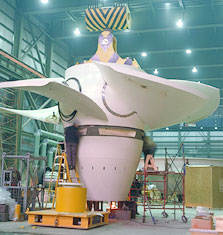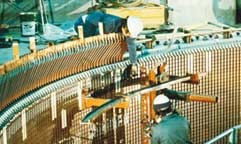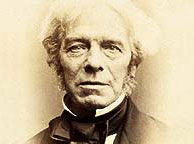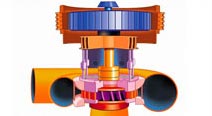Turbine – generator unit
The role of the turbine is to transform the energy of water, steam or wind into mechanical energy that will make the generator spin. The generator transforms the mechanical energy into electricity. In hydropower plants, this combination of generator and turbine is called a generating unit.
Moving water makes the turbine spin
In this generating unit, water rushes through the penstock and into the scrollcase. It turns the turbine blades and is then drawn to the turbine axis to exit through the underneath draft tube. The mechanical energy produced by the tremendous force that rushing water exerts on the turbine is transmitted to the generator, which then converts it into electrical energy.
Driven by the turbine, the generator produces alternating current
The generator is connected to the turbine drive shaft. It has a moving part–the rotor–and a fixed part–the stator. The rotor's outer surface is covered with electromagnets. The stator's inner surface, or cylinder wall, is made up of copper windings. When the rotor turns inside the stator, the electrons in the copper windings "vibrate." Their movement generates an electric current, similar to the one created by Michael Faraday in his 1831 experiment on electromagnetic induction, but on a much larger scale.

Installation of a Kaplan turbine
Turbines have a constant rotation speed
All the generating units in a power system must be synchronized. In other words, it's essential that they maintain an exact rotation speed. Why? To ensure adequate power quality. Equipment that runs on electricity is designed to use alternating current of a specific frequency. This frequency depends on the generating unit's rotation speed, i.e., the number of times per second that rotor magnets travel past the stator windings. This frequency is expressed in cycles per second, or hertz (Hz), named after the German physicist Heinrich Hertz, who proved the existence of radio waves.
In North America, the standard alternating-current cycle is 60 times per second, but in Europe it is 50 times per second. This means that a clock designed to work at 60 Hz will be slower when plugged into a European socket.
 Rotors at La Grande-3 generating station
Rotors at La Grande-3 generating station
At La Grande-3, the rotors have 32 pairs of electromagnets. To supply a 60-Hz alternating current, they must therefore rotate at a speed of 112.5 revolutions per minute (RPM).
Here is the formula that was used by the engineers:
32 pairs of electromagnets x 112.5 RPM
=
3,600 RPM or 60 revolutions per second (60 Hz).
 Michael Faraday, a British physicist and chemist, discovers the induction phenomenon.
Michael Faraday, a British physicist and chemist, discovers the induction phenomenon.
The scientist is the first to create an electric current by moving a magnet back and forth inside a metal winding. The innovative principles behind Faraday's discovery are quickly implemented and used to help meet the production needs of the industrial era. The first electric generator, precursor to today's generating units, was created based on these principles. Faraday's experiments sparked the invention, by other researchers, of the first electric motor and the first transformer (essential for the transmission of electricity).
 Cross-section view of a generating unit
Cross-section view of a generating unit
